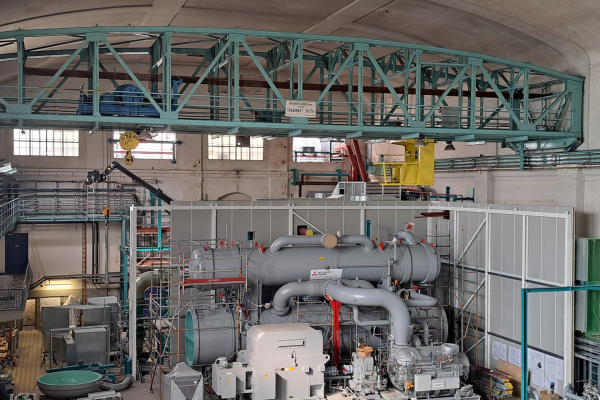 Quelle: EnBW / Fotograf ARTIS-Uli Deck
Quelle: EnBW / Fotograf ARTIS-Uli Deck
Important milestones reached in the living lab for the energy transition
Save CO2 with Large-Scale Heat Pumps
In the supply of district heating, the integration of large-scale heat pumps can reduce CO2 emissions. The living lab for the energy transition “GWP” is showing how this is possible at five differently structured power plant sites. The operation of such a plant has now been started in Stuttgart-Münster.
In the future, a large-scale heat pump will make an important contribution to reducing CO2 emissions at the Stuttgart-Münster site. This will feed climate-friendly heat into the local district heating network. The entire project is part of the living lab for the energy transition focused on the installation, operation, monitoring, and system integration of large-scale heat pumps (LHPs) in district heating networks, which is funded by the German Federal Ministry of Economic Affairs and Climate Action.
Possible CO2 savings of around 15,000 tonnes per year
The large-scale heat pump in Stuttgart-Münster uses waste heat from the cooling water discharge of the nearby residual waste cogeneration plant to generate up to 24 megawatts of district heating. It is powered by certified green electricity from waste incineration. With the large-scale heat pump having now been officially put into operation, around 15,000 tonnes of CO2 can be saved annually and 10,000 households will be able to receive climate-neutral district heating. The share of this climate-friendly energy form in the Stuttgart region will thus increase by around 10 % in future.
Power plant operations had to continue during new construction
The large-scale heat pump also ensures that the heat input into the Neckar River is reduced and that the energy contained in the cooling water can be used to generate climate-neutral district heating. A particular challenge for the project was to integrate the new large-scale heat pump into the existing facilities of the power plant, which has been in operation for a very long time, while maintaining operations at the site. The new equipment was integrated into the existing infrastructure and buildings
Starting signal for more climate friendliness
At the EnBW site in Stuttgart-Münster, a new gas-fired power plant (output of 124 megawatts) will generate electricity and heat with fewer CO2 emissions in future alongside the large-scale heat pump. The power plant will initially use natural gas. However, its new turbines are designed in such a way that they can also burn “green” gases such as hydrogen from renewable energy sources.
River Heat Pump in Mannheim Also Supplies Climate-Friendly Energy
At the four other locations of the GWP living lab for the energy transition in Mannheim (MVV Energie AG), Rosenheim (Stadtwerke Rosenheim) as well as Berlin-Neukölln (Fernheizwerk Neukölln) and Berlin-Köpenick (Vattenfall Wärme Berlin), the respective power plant operators and energy suppliers are also building their large-scale heat pumps close to existing heat generator locations.
In October 2023, a 20-megawatt river heat pump was put into operation at the large power plant in Mannheim. This feeds both into the existing district heating storage facility and directly into Mannheim’s district heating network, ensuring that around 3,500 households are supplied with heat, which is also obtained from the water of the Rhine. By using the new pump, up to 10,000 tonnes of CO2 can now be saved annually in Mannheim. (Further information can be found here)
At the Rosenheim site, two large heat pumps have already been integrated into the processes of its combined heat and power plant. As a result, the energy supplier saved CO2 for the first time in 2022. Among other things, it benefited from close collaboration with scientists from the Fraunhofer Institute for Solar Energy Systems ISE and the University of Stuttgart. As at the other sites, the teams are testing on site how the large heat pumps can be efficiently integrated into the existing structure and how their operation can be optimized. In addition to technical findings, the experts want to determine how regulatory and economic framework conditions need to be adapted, to better establish large-scale heat pumps in the district heating market.
Other Living Labs for the Energy Transition in Germany
In general, innovative technologies are tested in practical applications under real conditions and on an industrial scale in the living labs funded by the German Federal Ministry of Economic Affairs and Climate Action. Experts can then use the experience gained in the projects to decisively advance the far-reaching transformation of the energy system in Germany toward climate neutrality.
On the topic of “energy-optimized neighbourhoods”, five other living labs for the energy transition have already been launched:
DELTA – Darmstadt Energy Lab for Technologies in Application
JenErgieReal – Energy-optimized living lab in Jena using real-time scalable energy storage
IW3 – Integrated heat turnaround Wilhelmsburg
TransUrban.NRW
SmartQuart – Smart energy districts
GeoSpeicher Berlin (in German)
Five living labs for the energy transition have also already been launched in the area of “sector coupling and hydrogen technologies”. An overview of all projects and further information on the topic can be found here.












